
Fall Lawn Care in Dallas: Is Your Yard Prepared?
With the relentless heat of the Dallas summer finally behind us, it’s time to switch gears when it comes to lawn care and start preparing your yard for winter. Following are some of the lawn care tasks on our to-do list with clients this time of year.
Fertilizing
Fertilizer formulas contain three numbers that indicate the amount of nitrogen, phosphorus, and potassium in the mix. Nitrogen promotes lawn blade growth, phosphorus helps root growth, and potassium promotes cell function and absorption of  trace elements. Fall is the time to feed your lawn for root growth with higher levels of potassium. This will strengthen your lawn’s roots and help it stay healthy throughout the winter months, while at the same time providing a strong base on which it can thrive next spring. At the same time, you want to use a mix that provides lower levels of nitrogen because you do not want to promote an abundance of new blade growth that can weaken your lawn’s root system and make it susceptible to disease and potential freeze damage.
trace elements. Fall is the time to feed your lawn for root growth with higher levels of potassium. This will strengthen your lawn’s roots and help it stay healthy throughout the winter months, while at the same time providing a strong base on which it can thrive next spring. At the same time, you want to use a mix that provides lower levels of nitrogen because you do not want to promote an abundance of new blade growth that can weaken your lawn’s root system and make it susceptible to disease and potential freeze damage.
For best results, check the weather report before fertilizing to avoid applying before a rainstorm. Heavy rain can cause many of the nutrients to leach out of the soil before the grass can use them. For best results, use a slow-release fertilizer and after applying fertilizer, gently water your lawn just enough to wash the fertilizer off the blades and into the soil.
Apply Pre-Emergent Herbicides
Now is also the time to apply pre-emergent herbicide as part of your lawn care regimen. Pre-emergent herbicides are not designed to control existing weeds or weed seeds. Rather, as the name suggests, weeds are killed when the weed seeds spout and hit the herbicidal barrier. Because the seed is allowed to germinate and the sprout is killed, the weed is eliminated permanently. Weed seeds can remain dormant and viable many years, which is why weed control is a constant process. Pre-emergents break the cycle of constant regrowth of new weeds.
You should avoid treating your lawn with pre-emegents on a windy day because herbicide drift can injure ornamental plants. Also, use caution to not treat under trees and shrubs as some pre-emergents can damage roots and throw plants into distress. It is possible to incorrectly apply pre-emergent herbicides in this way for years and not detect any problems, only to see trees nearly die in a matter of days.
Overseeding
In Dallas our clients’ lawns are often warm-season grasses such as St. Augustine, Bermuda, buffalo and zoysia. In the winter when these grasses go dormant, they turn brown. Overseeding a warm-season lawn with a cool-season perennial ryegrass allows you to have an attractive green lawn year-round. Ryegrass will die off as temperatures rise in the spring, making way for the return of the warm season grasses. It is important to keep in mind, however, in the spring when the warm season lawn is trying to come out of dormancy it is forced to compete with the ryegrass, which is still in full swing, for nutrients and space. This can result in weak or thin areas in your lawn in the early summer. For this reason, we do not recommend overseeding warm season turfs in shaded areas.
Tall fescue grass is another popular choice for lawns in Dallas. Unlike the grasses mentioned above, tall fescue is a deep-rooted, cool season, perennial grass that stays green all year. It grows vigorously in the spring and fall, is shade-tolerant, and has an extensive root system that helps it withstand drought conditions. Many tall fescue lawns become thin after hot, dry summer conditions and a thinned tall fescue lawn forms clumps and becomes unsightly. To prevent this from occurring, it’s usually necessary to overseed fescue lawns in the fall with fescue.
Preventing Brown Patch
St. Augustine, Bermuda and zoysia turfs are susceptible to brown patch, although St. Augustine is most susceptible. Brown patch is a fungal disease that develops rapidly and is very difficult to prevent. It is most likely to develop in warm fall and winter temperatures (68° to 90°) when it is humid. Because of this, it is important to limit watering during the months when the grass is dormant. It is best to water only when needed and do so in the morning to a depth of 4 to 6 inches. It is also important to follow good mowing practices, including keeping your mower blades sharp, mowing your lawn to the correct height, and washing and sterilizing your lawn blades after each use so that you do not spread any disease. There are other preventative measures that can be taken and treatments to help prevent the spreading of the disease once your lawn is infected, but in either case is important to act quickly to lessen both the potential for, and spread of the disease.
For over 30 years, Bonick Landscaping, has served Dallas area clients with the highest standards looking for out-of-the-ordinary luxury landscape design and pools by offering the best in service, workmanship, and plantings. Services include hardscape and landscape design, pool designs, pool construction and installation, estate management, lawn care services and garden maintenance, pool maintenance, and more. For discerning clients in Dallas who want to express their own distinctive style through their landscaping, Bonick Landscaping can help you realize your dream. Call us at 972-243-9673 or visit our website at www.bonicklandscaping.com.
